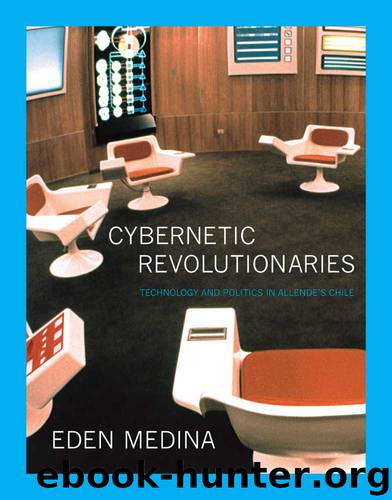Cybernetic Revolutionaries by Eden Medina

Author:Eden Medina [Medina, Eden]
Language: eng
Format: epub
ISBN: 9780262297387
Publisher: The MIT Press
Published: 2011-04-10T04:00:00+00:00
6
Cybersyn Goes Public
Does it take more courage to be a cybernetician than to be a gunman?
—Stafford Beer, April 1973
The Cybersyn team began 1973 on a high note. By this point, both the temporary and permanent suites were running and processing production indicators from select factories. The CHECO economic models remained simple, but the economic modeling team had also made significant strides and no longer needed guidance from Ron Anderton in London. And the operations room was a functioning prototype by 10 January.
Flores was still a member of Allende’s cabinet, but around the first of the year he left his post as minister of economics, to which he had been appointed only two months earlier, to become minister of finance. This latest presidential appointment took Flores even further from Project Cybersyn, although the Cybersyn team had not yet felt the full ramifications of losing his political leadership. Raúl Espejo began 1973 as head of the newly formed informatics directorate in the State Development Corporation and had secured financing for the project from the agency. The number of people working on Cybersyn continued to grow.
These positive developments stood in sharp contrast to the deteriorating political and economic situation that confronted the Popular Unity government. Chile started 1973 with a trade deficit of $438 million, declining production, and a 180.3 percent increase in prices in the previous twelve months.1 The class war intensified in the aftermath of the October Strike, exacerbating political polarization. As more Chileans moved from the center to the right, either civil war or a military coup became an increasingly real possibility. Members of the opposition vowed to take back the country, either in the upcoming congressional elections in March 1973 or through tactics of economic sabotage, political and legal obstructionism, and violence. Yet those working on Project Cybersyn felt their efforts might still help the Popular Unity government, the Chilean economy, and the Chilean nation.
Back in Britain, Stafford Beer also began the new year with a positive outlook. Now that cybernetic thinking had produced concrete benefits for the Chilean government through the use of the telex network, the cybernetician believed he would have new opportunities to apply his ideas. While cybernetics had already proved useful to the government in managing Chile’s “war economy” during the October Strike, it also held the potential to advance the social transformations taking place on the shop floor and in Chilean communities. Beer believed his cybernetic science could help Chilean workers increase their role in factory management as well as enable the Chilean people to have a greater role in national governance. He planned to continue developing these ideas in 1973 and to push for their implementation.
Beer was also excited because the Chilean government had finally given him permission to make his work on Project Cybersyn public. For months he and the Chilean team had debated making a public announcement, but the Chileans had always concluded the timing was not right. They worried an announcement would
Download
This site does not store any files on its server. We only index and link to content provided by other sites. Please contact the content providers to delete copyright contents if any and email us, we'll remove relevant links or contents immediately.
Algorithms of the Intelligent Web by Haralambos Marmanis;Dmitry Babenko(8529)
Test-Driven Development with Java by Alan Mellor(7443)
Data Augmentation with Python by Duc Haba(7332)
Principles of Data Fabric by Sonia Mezzetta(7080)
Learn Blender Simulations the Right Way by Stephen Pearson(7023)
Microservices with Spring Boot 3 and Spring Cloud by Magnus Larsson(6840)
RPA Solution Architect's Handbook by Sachin Sahgal(6253)
Hadoop in Practice by Alex Holmes(6039)
The Infinite Retina by Robert Scoble Irena Cronin(5956)
Jquery UI in Action : Master the concepts Of Jquery UI: A Step By Step Approach by ANMOL GOYAL(5878)
Big Data Analysis with Python by Ivan Marin(5745)
Life 3.0: Being Human in the Age of Artificial Intelligence by Tegmark Max(5410)
Pretrain Vision and Large Language Models in Python by Emily Webber(4703)
Infrastructure as Code for Beginners by Russ McKendrick(4485)
WordPress Plugin Development Cookbook by Yannick Lefebvre(4214)
Functional Programming in JavaScript by Mantyla Dan(4129)
The Age of Surveillance Capitalism by Shoshana Zuboff(4126)
Embracing Microservices Design by Ovais Mehboob Ahmed Khan Nabil Siddiqui and Timothy Oleson(4005)
Applied Machine Learning for Healthcare and Life Sciences Using AWS by Ujjwal Ratan(3982)
